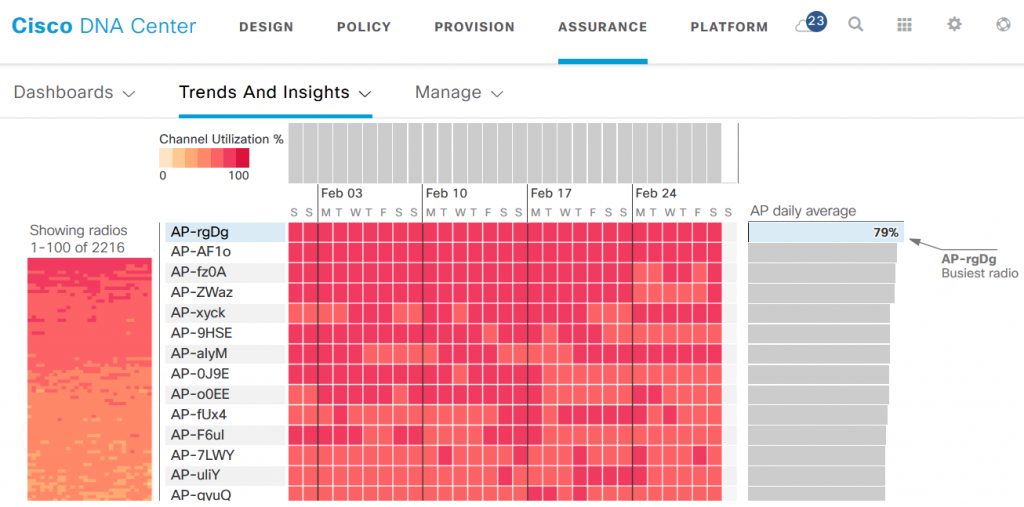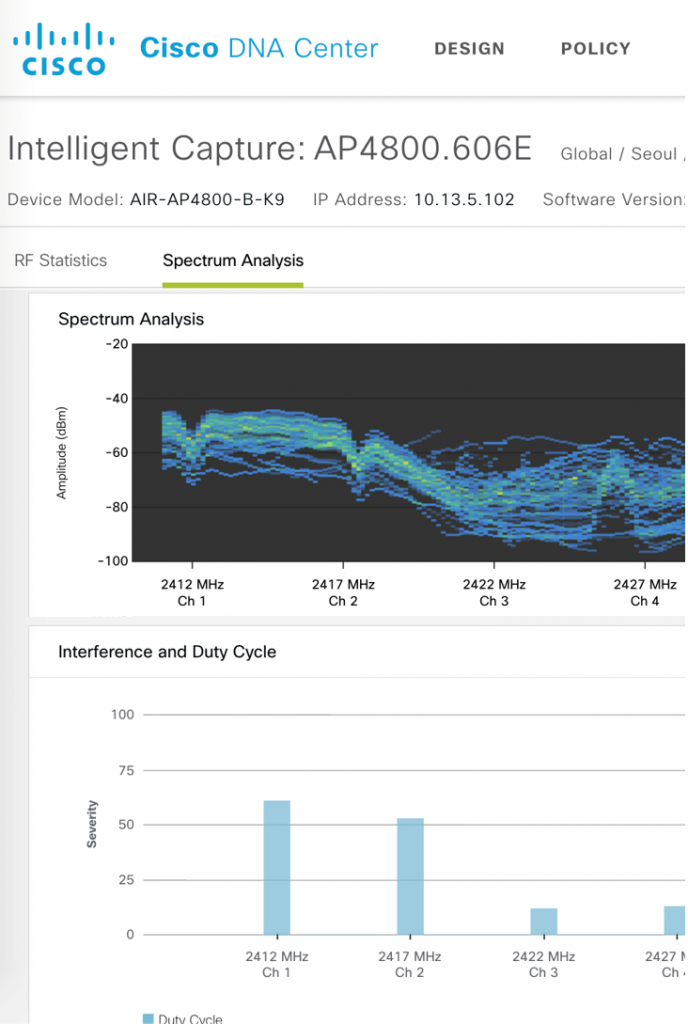Why Artificial Intelligence when implementing WiFi6?
When planning the transition to Wi-Fi 6, it is important to start with those areas where Wi-Fi 6 capabilities will significantly improve network performance and user connection quality. This will be helped by Artificial Intelligence / Machine Learning (AI / MO) implemented in the Cisco DNA Center – the network management center. AI / MO software monitors configurations, collects telemetry and allows you to make interesting measurements for users, devices and applications. MO algorithms make a complex correlation of events and allow you to assess the situation taking into account the context, helping to solve specific problems.
What problems in an existing wireless network will Wi-Fi 6 solve?
- Poor network performance in congested areas
- Poor mobile device performance in the uplink
- High level of radio interference
- Network congestion with IoT traffic
The AI / MO at Cisco DNA Center will help us identify problem areas in the wireless network.
Overloaded areas
802.11ac / Wi-Fi 5 with MU-MIMO works well in congested areas. We need to replace access points with Wi-Fi 6 only in areas where congestion causes a decrease in performance and a decrease in the quality of the user’s connection. In the Assurance menu of the Cisco DNA Center in the “Trends and Insights” section, using AI / MO, you can compare almost everything with everything on your campus network – for example, wireless network performance between buildings, floors and specific access points. The utilization schedule of the radio channel ranks the access points from highest to lowest. With high utilization of the radio channel, the radio resource is almost constantly occupied and the access point is inefficient. Let’s see the level of packet loss at points with high utilization of the channel. As a result, we obtain those access points that have high levels of (1) channel utilization and (2) relay. Replacing these access points with Wi-Fi 6 is a good idea. The Cisco DNA Center, by the way, allows you to rewind the picture on a typical campus day and take statistics from there.

Areas in which it is not easy for mobile devices
Mobile devices transmit in a Wi-Fi interface with less power than access points do (usually 15mW versus 100mW). Because of this, asymmetric channel situations arise when mobile devices cannot send uplink data with a good signal level from the access point. The user is perplexed – I have good Wi-Fi, 4 sticks on the indicator! A good signal level is measured from the access point (downlink), with the existing problem in the uplink. This problem manifests itself in different ways, because the interference pattern (interference) in each room is different, concrete and metal structures reinforce the uplink problem. OFDMA in Wi-Fi 6 allows the mobile device to concentrate the transmission in a narrower channel to increase power. This works roughly like a watering nozzle in a country house, which increases the pressure of a stream of water. As a result, Wi-Fi 6 allows low-power devices to achieve a better signal level and increase SNR (signal-to-noise ratio) in the uplink, which is important in environments with multiple reflections. How to identify areas where Wi-Fi clients are experiencing uplink transmission quality problems?

Using AI / MO in the “Trends and Insights” menu, we will see the average RSSI (Received Signal Strength Indicator) of client devices for all access points on the campus. Get a picture of how the dots hear their wireless clients. Access points with RSSI below average make sense to replace with Wi-Fi 6.
High Noise Areas
Users may experience a long network connection, poor application response, and difficulty connecting to the cloud due to the high level of interference on the wireless network. The AI AI Network Analytics functionality in the Cisco DNA Center automatically detects interference and issues an alert in the “Top 10 Issues” window on the main control panel. In the Trends and Insights AI / IO menu, you can sort access points by interference level.
Click on the access point and look at the “Intelligent Capture” tool. It performs sophisticated analysis of packets, frames, and radio environments. Click on the spectrum analysis. The waves show the channels on which interference is present and the effect of this interference on the operation of a given access point. Intelligent Capture allows you to detect and analyze interference even if its source is not Wi-Fi.

The picture shows the result of spectral analysis in the 2.4 GHz band. On channels 1 and 2, a high level of interference, unlike channels 3 and 4. If the interference is limited to one or two Wi-Fi channels, you can configure the access point so as not to use them. However, if interference is present on all channels, you have a good candidate for replacement for Wi-Fi 6. OFDMA in Wi-Fi 6 minimizes intra-channel interference, in addition, Wi-Fi 6 clients can transmit information with more power in narrower channels, increasing immunity to external interference.
The problem of small IoT packages
This problem is known in Wi-Fi networks used for inter-machine traffic (M2M) or video surveillance. This type of communication means transferring a small amount of data at a high frequency. Most often, M2M encapsulates data in 64-byte UDP packets, while regular IP file transfers use large packets of 1,500 bytes. The Wi-Fi hotspot is limited by the number of packets per second (PPS) that the chipset can handle. Imagine a Wi-Fi chipset capable of handling 30,000 PPS. For normal packets of 1,500 bytes, this device transfers 360 Mb / s (30,000 x 1500 x 8). But for 64 byte packets, the maximum performance drops to 45 Mb / s. T.O. 20 Mb / s of M2M traffic will take up almost half the performance of the access point.
To detect the problem of small packets, go to the “Trends and Insights” AI / MO menu and sort the access points by traffic (“Traffic”). This will determine the busiest access point for packet transmission. We use Intelligent Capture, but this time we will look at the frame counter and frame errors. Any access point with a large traffic load, a large number of frames and frame errors are excellent candidates for replacing with Wi-Fi 6.


Cisco has developed a range of technologies to circumvent the limitations of typical Wi-Fi chipsets, for example HDX and “Turbo Performance” for the Cisco Aironet 2700 Series and 3700 Series for 802.11ac. 4-core HDX technologies are now available on the new Wi-Fi 6 chipsets and take packet processing performance to the next level.
Additional materials:
Fundamentals of Wi-Fi 6: Capacity Is the New Metric
Cisco Catalyst Wi-Fi 6 Access Points
Cisco DNA Software for Wireless





